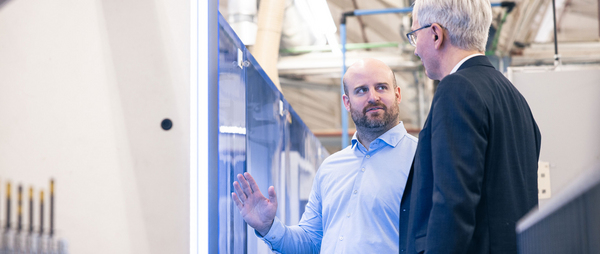
An article from the HK magazine issue 02/2023 (May 2023).
Increasing the total output with the same use of resources - the OEE workshop developed by Schuler Consulting and Homag aims to do just that and offers a practical approach to all those who want to increase the added value in their plant. The workshop looks at manufacturing as a whole and analyses the influences on the factors of availability, performance and quality. Philipp Bräuer (Schuler Consulting) and Simon Liller (Homag) report on what an OEE potential analysis looks like in practice.
Identifying the causes of errors and preventing machine downtimes
It is a well-known problem: resources such as time, skilled workers, machines, material and energy must be used in the best possible way to cope with high production pressure. OEE analyses help to understand and prevent machine downtimes and organisational or unfounded interruptions, thereby increasing the effectiveness of production with the available resources. Overall Equpiment Effectiveness (OEE) is a measure of availability, performance and quality. This key figure contains the essential elements that have an influence on productivity and thus on the economic efficiency of processes and plants. Our experience shows: For long-standing plants, the OEE potential is an increase of ten percent and more.
One of the most important results of an OEE potential analysis is transparency: Why do machine downtimes occur? Where are the causes of faults? Where does waste occur? To find out, we use different data and process analysis tools according to the globally successful Lean Six Sigma methodology. We analyse the factors influencing OEE (availability, performance, quality) in joint workshops with manufacturing companies to identify waste and disruption factors and derive optimisation measures. Depending on the scope of the project, the solutions developed are implemented together with the customer and sustainability is ensured. Schuler Consulting and Homag pursue a partnership approach in the area of OEE in order to achieve the best possible result through the interaction of optimisation know-how and mechanical engineering expertise.
Five steps to more effectiveness - The DMAIC cycle
The methodological basis of an OEE project is the "DMAIC" cycle. Based on the Lean Six Sigma method, we develop optimisation proposals to sustainably increase overall plant effectiveness. We proceed in five steps, which give the method its name: Define, Measure, Analyse, Improve and Control.
"Define" - We record the initial situation and make it measurable. In a workshop, we define the project goals together with the customer and record the relevant production processes. This means that processes are visualised and discussed. For this purpose, we conduct customer interviews with machine operators, maintenance staff or employees in work planning. In the end, everything culminates in a clearly defined project profile.
"Measure" - In this phase we collect all relevant data for determining the OEE for a certain period of time and record the processes. Both historical data and newly collected data can be used. Finally, we calculate the current process performance. In addition to the direct measurement of process performance, i.e. the concrete overall plant effectiveness, we also measure indirect process performance such as spare parts movements, maintenance deployments or concrete machine condition or malfunction data.
In the analyse phase, we carry out extensive data and process analyses with the help of Lean Six Sigma tools. Here, for example, we analyse the recorded machine condition data or fault messages. We identify how the previous process performance comes about and identify causes for too frequent, recurring malfunctions, too long unjustified waiting times or too high a rework rate.
The subsequent "Improve Phase" puts the insights gained into practice: now we jointly develop solution concepts for production. These solutions cover the entire manufacturing process, from concrete modernisations or software updates to process-related changes in the material flow and new ways of working in work preparation. All solutions are adjusted to their effect in the value stream during the Improve phase. Typical questions here include compatibility with other production routes or typical hurdles within change processes. It is also central to check the optimisation approaches developed for economic efficiency and, if possible, to test or simulate them.
In the last phase, the "control phase", the implementation of the measures begins. It is important to monitor the process closely and document all anomalies. If the process performance decreases, a reaction plan with predefined measures intervenes.
In previous projects, an increase in overall plant effectiveness of between three and fifteen percent was measurable. Of course, this always depends on the initial situation, so it is difficult to make sweeping statements. Our experience shows that the OEE potential for long-standing plants is over ten per cent. Based on the customer's requirements, an OEE project can take anywhere from a few days to several weeks. The duration is individual. Regardless of this, the production as a whole is considered in every project.
Practical example: Arbonia Group (Prüm and Garant)
The Arbonia Group is a building supplier with headquarters in Arbon (Canton Thurgau, Switzerland) and several production sites in Europe. The group comprises two divisions: The "Indoor Climate" Division (heating, ventilation and air conditioning technology) and the "Doors" Division (wood and glass), which includes the "Garant" and "Prüm" brands, among others. In summer 2021, an OEE project was carried out in the "Interior Doors" Division at the group.
There are clear growth targets for the Doors Division in the coming years: Through the further capacity expansion of production facilities as well as the development of additional market shares, turnover is to be increased by up to 30 percent. According to the Division's own forecasts, an output of 3.4 million doors and frames per year is possible as early as 2023, with the same number of employees. The adjusting screws that are to make the growth of the group of companies possible lie in production: The reason for the project was to identify the process weaknesses and significant factors influencing the OEE of two production lines for doors. For this purpose, the team checked the performance of the lines and uncovered potential for improvement.
Horst Lichter (Overall Technical Manager, Prüm and Garant) reports: "Every user of a machine or plant should be able to assess exactly what the status quo (performance, availability, plant effectiveness, etc.) of their plant is. In this respect, an OEE workshop is more than useful after a certain start-up phase. The recording must be done very transparently and, if possible, from a neutral point of view. Only then are the results representative and can be used for improvements."
In order to achieve ambitious growth targets while maintaining the same level of resources, a high level of employee commitment is required. "Success depends on man and machine," emphasises Lichter. A neutral view from the outside, he says, was therefore very important in this project. "If results are determined and presented by a neutral person, they are accepted much faster than if the results come from within the company."
For Lichter, an OEE analysis has become an established means of uncovering optimisation potential: "An OEE workshop should be used as a standard tool. There is no rule as to when the right time is. I think a workshop is necessary when you feel you are stuck."
On the one hand, an OEE workshop serves to take stock: where does my company stand today? What is the status quo? What is the potential for optimisation? In the second step, after the analysis of the current situation, the implementation of the measures identified is the next step. This is where the "real" work begins for the companies themselves - and this is where the greatest risk lurks: change takes time, requires readiness, requires implementation. In the two-week project, the OEE team proceeded according to the five steps of the "DMAIC" cycle and was able to develop a list of optimisation potentials. Horst Lichter is satisfied with the findings from the workshop. There is a whole series of "low hanging fruits" and a plan of action that is now being successively put into practice, says Lichter.
Thanks to the good commitment of the Arbonia Group staff, the project was completed to the full satisfaction of all parties. "The cooperation was with 'open sights' right from the start! All the employees involved from a wide range of departments got involved. HOMAG competently took over the coaching as well as the subsequent evaluations," summarises Lichter.
Outlook
An OEE analysis can be used both as an "ad hoc" measure and to mark the start of a continuous optimisation process. In both cases, production is analysed individually as a whole. In our experience, companies that are committed to the continuous optimisation of their production and work daily to improve their production are those that are more successful in the long term. Our clear recommendation is therefore to look at the topic of "OEE" not just once, but in the long term, and to bring in experts to implement the optimisation measures.
For those who want to go one step further and are looking for a solution to optimise the entire value stream, Schuler Consulting offers "Digital Value Stream Optimisation": a "tracker for production" (see issue HK 05-2022). In "Digital Value Stream Optimisation", a scalable consulting service from SCHULER Consulting, the team of consultants uses a technical set-up to record machine data, material and value streams in production continuously, manufacturer-independently and digitally. These "digital traces" are used in particular to analyse and optimise those processes for which there has been an insufficient data basis in the companies up to now. Through regular optimisation workshops, in which the methods from OEE workshops are also used, companies can increase the overall output of their production in the long term.
Authors:
Philipp Bräuer works in the Industry 4.0 team at Schuler Consulting. His core tasks include factory planning and production optimisation. The trained carpenter, wood engineer and REFA specialist is involved in process analysis and optimisation at OEE workshops.
Simon Liller is Product Manager Service Solutions and works in Homag's Life Cycle Services division. The product manager is a trained Lean Six Sigma Green and Black Belt and is active in OEE projects in industry.

